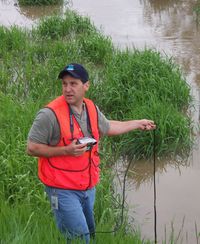
Municipal operation inspections
Contents
Municipal operation inspections
Municipal operation inspections help reduce the impacts to stormwater from municipally owned or operated facilities, areas, or stormwater best management practices (BMPs). Staff conducting these inspections can stop pollution before it reaches stormwater, or minimize the impacts if your BMPs have failed or need maintenance.
The municipal separate storm sewer system (MS4) General Permit requires inspections of the following: (MS4 General Permit Part III.D.6.e)
- Annual inspections of structural stormwater BMPs to determine structural integrity, function, and maintenance needs.
- At least one inspection every permit term of stormwater ponds and outfalls to determine structural integrity, function, and maintenance needs.
- Quarterly inspections of stockpiles, and storage and material handling areas identified in the Facility Inventory to determine function and maintenance needs.
During each of these inspections, inspectors must look for evidence of illicit discharges (MS4 General Permit Part III.D.3.c.). All inspections must be documented (MS4 General Permit Part III.D.6.h.(1)), so save any checklists that you are using.
Municipal Operations inspections required by the MS4 General Permit
For a PDF version of this table, click here.
| What to inspect | When to inspect | Why inspect | Examples of how-to inspect | What to document |
|---|---|---|---|---|
| Structural stormwater best management practices (BMPs) including green roofs, permeable pavement, infiltration basins or trenches, raingardens, filtration devices, sand filters, hydrodynamic devices, etc. [Part III.D.6.e.(1)] | Annually | To determine structural integrity, proper function, and maintenance needs |
|
|
| Outfalls where an MS4 discharges to a receiving water, or the discharge permanently leaves the MS4 [Part III.D.6.e.(2)] | Once per each permit term | To determine structural integrity, proper function, and maintenance needs |
|
|
| Stormwater ponds [Part III.D.6.e.(2)] | Once per each permit term | To determine structural integrity, proper function, and maintenance needs |
|
|
| Stockpiles, and storage and material handling areas that are inventoried in the Facilities Inventory [Part III.D.6.e.(3)] | Quarterly | To determine maintenance needs and proper function |
|
|
| Illicit discharges (Part III.D.3.c.&f.) | During the structural stormwater BMP; outfall; pond; and stockpile and storage and materials handing inspections | To identify and eliminate illicit discharges to the MS4 |
|
Dates and locations of IDDE inspections conducted [Part III.D.3.h.(1)] |
| Construction activity | At the frequency identified in the Construction Site Inspection procedure for your MS4 | To prevent and minimize erosion to reduce the amount of sediment from entering your MS4 |
|
Checklist or other written means to document what was inspected for [Part III.D.4.h.(1)] |
Resources
Fact sheets and guidance documents
- MPCA Managing Stormwater Sediment BMPs guidance - Guide for properly managing sediment from stormwater systems, such as ponds
- Documentation that MS4 staff should retain - List of all the documentation requirements (what information to keep, how long to keep it, level of detail to keep, etc.) for compliance with the MS4 permit
Checklists and templates
BMP inspection checklists
- Rain garden/bioretention basin inspection checklist - University of Minnesota's (U of M) checklist for inspecting bioretention systems, such as rain gardens
- Constructed wetland inspection checklist - U of M's checklist for inspecting constructed wetlands
- Filter strips and swales inspection checklist - U of M's checklist for inspecting filter strips and swales
- Filtration system inspection checklist - U of M's checklist for inspecting filtration systems
- Infiltration system inspection checklist - U of M's checklist for inspecting infiltration systems
- Underground sedimentation inspection checklist - U of M's checklist for inspecting underground sedimentation devices
- Permeable pavements inspection checklist - U of M's checklist for inspecting permeable pavers
- Green roof maintenance inspection checklist - MPCA's inspection checklist for inspecting green roofs
Pond inspection checklists
- Wet pond inspection checklist - U of M's checklist for inspecting wet ponds
- Dry pond inspection checklist - U of M's checklist for inspecting dry ponds
Outfall inspection checklists
- Outfall inspection checklist - City of Rochester's checklist for inspecting outfalls
- Outfall inspection checklist - City of Arden Hills' checklist for inspecting outfalls
This page was last edited on 31 January 2023, at 16:17.
